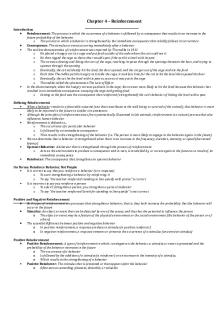Psych 282 Prompting and Stimulus Control PDF

| Title | Psych 282 Prompting and Stimulus Control |
|---|---|
| Course | Behavior Modification |
| Institution | University of Alberta |
| Pages | 2 |
| File Size | 63.5 KB |
| File Type | |
| Total Downloads | 618 |
| Total Views | 703 |
Summary
Prompts Used to increase the likelihood that a person will engage in the correct behavior at the correct time Verbal prompts Instructions, tools, hints, reminders, questions Gestural prompts Any physical movement or gesture of another person the leads to the correct behavior of the SD Modeling promp...
Description
Prompts Used to increase the likelihood that a person will engage in the correct behavior at the correct time Verbal prompts Instructions, tools, hints, reminders, questions Gestural prompts Any physical movement or gesture of another person the leads to the correct behavior of the SD Modeling prompt Demonstration of correct behavior makes it more likely that the correct behavior will occur at the right time Fading Gradual elimination of the prompt as the behavior continues to occur in the presence of the SD. One way to transfer stimulus control from the prompts to the SD. Response prompts Trainer engages in a behavior to induce the client to engage in the target behavior in the presence of the discriminative stimulus. Verbal prompts, gestural, modeling, physical Stimulus prompt Some change in an antecedent stimulus or the addition or removal of an antecedent stimulus, with the goal of making a correct response more likely. Within-stimulus prompt A type of stimulus prompt in which some aspect of the discriminative stimulus or S is changed to help make a correct discrimination (easier to distiguish Extra-stimulus prompt A type of stimulus prompt in which a stimulus is added to help a person make a correct discrimination Response Prompt fading most commonly used method of transferring stimulus control A response prompt is removed gradually across leaning trials until the prompt is no longer provided Prompt delay Present SD, wait a certain amount of seconds, if the correct response is not made, you provide the prompt Stimulus fading The gradual elimination of a stimulus prompt as the behavior continues to occur in the presence of the discriminative stimulus How to use prompting and transfer of stimulus control 1.Choose the most appropriate prompting strategy 2.Get the learners attention 3.Present the SD 4.Prompt the correct response 5.Reinforce the correct behavior 6.Transfer stimulus control (fading) 7.Continue to reinforce unprompted responses Physical guidance
Application of physical contact to induce an individual to go through the motions of the desired behavior Transfer of stimulus control A process in which prompts are removed once the target behavior is occurring in the presence of the discriminative stimulus (SD). Prompt fading and prompt delay are procedures used to transfer stimulus control from the prompt to the SD Three-step prompting use prompts progressively, starting with verbal, then modelling, and finally physical guidance prompts fading within prompt same prompt is used, but is decreased in magnitude or intensity fading across prompts Prompt is changed, according to a prompting hierarchy Most to least prompting and fading the most intrusive prompt is used first and is then faded to less intrusive prompts used when skill is not in repertoire (physical guidance> modelling> gestural> verbal) -multiple sessions Least to most prompting Fading from one type of prompt to another, going from most assistance to least assistance. usually used for behaviors that have already been learned Graduated Guidance Give prompts where they are required, but immediately fade when a person begins to perform the response...
Similar Free PDFs

Psych 282 - Final Summary
- 4 Pages

Psych 282 - Chapter 9 - Shaping
- 4 Pages
Popular Institutions
- Tinajero National High School - Annex
- Politeknik Caltex Riau
- Yokohama City University
- SGT University
- University of Al-Qadisiyah
- Divine Word College of Vigan
- Techniek College Rotterdam
- Universidade de Santiago
- Universiti Teknologi MARA Cawangan Johor Kampus Pasir Gudang
- Poltekkes Kemenkes Yogyakarta
- Baguio City National High School
- Colegio san marcos
- preparatoria uno
- Centro de Bachillerato Tecnológico Industrial y de Servicios No. 107
- Dalian Maritime University
- Quang Trung Secondary School
- Colegio Tecnológico en Informática
- Corporación Regional de Educación Superior
- Grupo CEDVA
- Dar Al Uloom University
- Centro de Estudios Preuniversitarios de la Universidad Nacional de Ingeniería
- 上智大学
- Aakash International School, Nuna Majara
- San Felipe Neri Catholic School
- Kang Chiao International School - New Taipei City
- Misamis Occidental National High School
- Institución Educativa Escuela Normal Juan Ladrilleros
- Kolehiyo ng Pantukan
- Batanes State College
- Instituto Continental
- Sekolah Menengah Kejuruan Kesehatan Kaltara (Tarakan)
- Colegio de La Inmaculada Concepcion - Cebu













